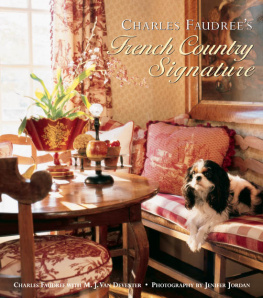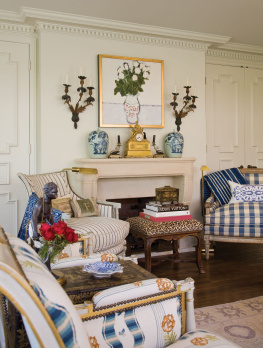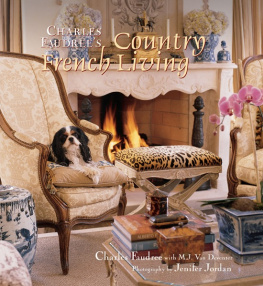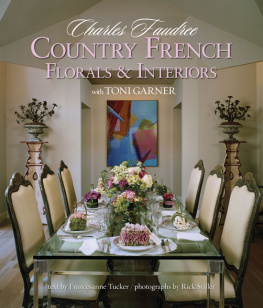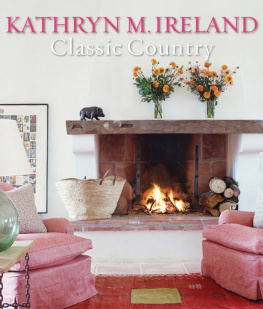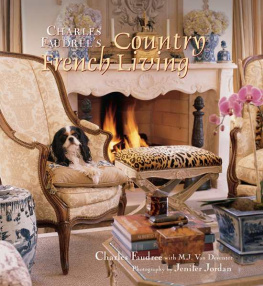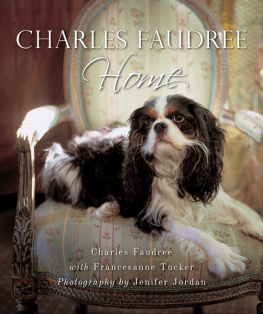All rights reserved. No part of this book may be reproduced by any means whatsoever without written permission from the publisher, except brief portions quoted for purpose of review.
1. Faudree, Charles. 2. Interior decorationUnited StatesHistory20th century. 3. Decoration and ornament, RusticFranceInfluence. I. Van Deventer, M. J. II. Title.
Whether its been a dream or a goal, I have always wanted to do a book before I was too old to remember all the pleasures of decorating other peoples homes, as well as my own. I am so pleased this book has finally come to pass, with everyones help.
I particularly want to thank and remember my mother for always allowing me to express myself, starting when I was only ten years old. She let me choose the color for the front door. It was a Dutch door with shutters and I got to paint it every year in whatever color I choseWedgwood blue, pink, apple green. I got that out of my system early on in my design career. Now I much prefer black.
I wish to offer my heartfelt thanks to the many people who helped make this book possible. I am especially indebted to the homeowners who graciously allowed us to enter their private worlds so we could share their homes with you. They include Joanne Hearst Castro, Leigh Farrar, Leigh Ann and Frank Fore, Dru and Michael Hammer, Mickey and Tom Harris, Judy and Paul Kantor, Julie and Warren Kruger, Patricia and Cleber Massey, Carol Pielsticker, Tracy and Hal Salisbury, Peter Walter and Holbrook Webb.
Thanks also to
Jenifer Jordan, photographer, for her beautiful photographs and for being ever so patient with me.
Nancy E. Ingram, photo stylist, for being my agent, president of my fan club and my dear friend.
M. J. Van Deventer, writer, for the wonderful words, for completing my sentences for so many years and for always making me sound better.
Jim Steinmeyer, illustrator, for the beautiful drawings and for being my closest friend.
Shawn Lovejoy and April Moore, my assistants, who took on extra responsibilities while I was involved with the book.
Cathy Keating and Tracy Salisbury, cheerleaders, who persistently encouraged me to do a book.
And finally, Madge Baird, editor, who has kept us on the path toward meeting the deadline and fruition of this project.
At Traditional Home, we do not keep statistics on how often a particular interior designer appears in the magazine. If we did, I can tell youwithout hesitationwhose name would have the most stories next to it: Charles Faudree. I dont have to thumb through my shelf of past issues or conduct a search of our electronic database to confirm this fact. Its just something all of us at the magazine know.
We also know that whenever we feature a house Charles has designed, we will receive many gleeful letters of thanks from our readers. To say that Charles is a favorite of Traditional Home readers is a huge understatement. If it is possible to conduct a love affair without ever meeting or speaking, our readers and Charles Faudree have been carrying on for years. Were merely the go-betweens.
Of course, we have our own special affection for Charles and his decorating. In 1995, we presented him with a Traditional Home Design Award for innovation and excellence in traditional style. During the course of our eight-year Design Award program, we honored almost fifty interior designers and architects, some who were quite famous, and others who were appearing in a national publication for the first time. The funny thing about giving Charles one of our awards was that it seemed redundant. Anyone familiar with Traditional Home already knew how highly we regarded his exuberant take on French Country style.
Several years ago, as we celebrated our tenth anniversary, we handpicked eight interior designers whose work we admired and asked them to appear in a book with our name on it. Traditional Home Signature Style presented visions of beauty in rooms and houses all across the country. Do I have to tell you the name of the designer whose chapter led off the book? Charles Faudree. Naturally.
As you will see in the pages of the book you are holding, Charles has a wonderful way with a room. He infuses a space with freshness and vitality, making it elegant and invitingbut most of all, personal. If you dont know it already, you will soon learn that Charles enjoys buying and selling his own houses (now thats a true understatement). In each homeand in an amazingly short amount of timeCharles puts his own stamp on the place. Every one of his houses is uniquely hisreplete with his prodigious collections, spilling over with comfort and exuding a sense of his having lived there forever.
Today, as I write this, Traditional Home is purchased and read by more people than any other upscale shelter and decorating magazine in America. Now, Im not going to tell you that we have arrived at this proud distinction because we have published so many houses designed by Charles Faudree.
Then again, it certainly didnt hurt.
Ann Omvig Maine
Editor in Chief, Traditional Home magazine
February 2003

In a library, an Empire mahogany armchair features bronze trim and flanks a coffee table accented with a pair of candlesticks, a crystal decanter, fresh flowers in a silver vase and part of a collection of English and French pocket watches.
In the language of interior design, I would like to think I have helped to elevate French Country to a fine art. It is an excessive, exuberant style that fosters my favorite design principletoo much is never enough. I would also like to think I have achieved a reputation for creating settings that have all the elegant accouterments of a French country estate, without any of the traditional French pretentiousness.
The style has its origins in the French countryside, straddling both the southern and northern regions of western Europe and drawing from many influences. Yet my version of French Country style is a colloquial look devoid of any precise boundaries. Always in the vernacular of this style, the name evokes images of farmhouses or small chteaux dotting the genteel French countryside. In our imagination, it is Monet revisited through a myriad of garden paintings, always reflecting the warmth of sunlight and lavender-filled fields.
I believe the style is defined by the furnishings themselves, with each region of France contributing a particular style. Many of the furnishings that make this look so special were used originally in French country chteaux, which were considered less important houses than those maintained in the French cities.

